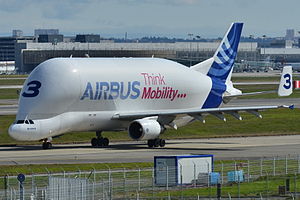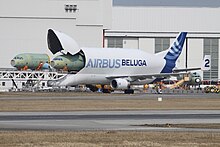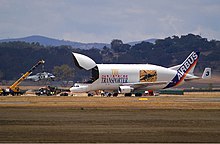Airbus Beluga
| A300-600ST Beluga | |
|---|---|

| |
| Beluga in the Airbus livery | |
| Role | Outsize cargo freight aircraft |
| Manufacturer | Airbus |
| First flight | 13 September 1994 |
| Introduction | September 1995 |
| Status | In service |
| Primary user | Airbus Transport International |
| Produced | 1992–c.1999 |
| Number built | 5 |
| Developed from | Airbus A300-600 |
The Airbus A300-600ST (Super Transporter) or Beluga, is a version of the standard A300-600 wide-body airliner modified to carry aircraft parts and oversized cargo. It received the official name of Super Transporter early on; however, the name Beluga, a large whale, gained popularity and has since been officially adopted. The Beluga XL, based on the Airbus A330 with similar modifications and dimensions, is being developed by Airbus to replace the type around 2020.
Development
Background
Several major aircraft manufacturers are multinational, and it is not unusual for them to have plants in widely separated locations. Airbus is unique in that it is a consortium formed by the major British, French, German, and Spanish aerospace companies. The geographic location of Airbus manufacturing is not only influenced by cost and convenience; it is also a matter of aviation history and national interest. Each of the Airbus partners makes an entire aircraft section, which must be transported to a central location for final assembly. The details vary from one model to another, but the general arrangement is for the wings and landing gear to be made in the UK, the tail and doors in Spain, the fuselage in Germany, and the nose and centre-section in France, with final assembly in either Toulouse, France; Hamburg, Germany; or Seville, Spain.

When Airbus started in 1970, road vehicles were initially used for the movement of components and sections; however, growth in production volume soon necessitated a switch to air transport. From 1972 onwards, a fleet of four highly modified "Super Guppies" took over. These were former Boeing Stratocruisers from the 1940s that had been converted with custom fuselages and the adoption of turbine engines to carry large volume loads for NASA's space program in the 1960s. Airbus' use of the Super Guppies led to the jest that "every Airbus is delivered on the wings of a Boeing".[1][2] As time went on, the Super Guppies grew increasingly unsatisfactory for Airbus's ferrying needs: their age meant that operating expenses were high and ever-increasing, and growing Airbus production required greater capacity.
Design phase
In 1991 Aérospatiale and DASA, two of the major Airbus partners, formed a company to develop a replacement. The starting point was the design for the wide-body twin-engined Airbus A300: the wings, engines, landing gear, and the lower part of the fuselage are the same as the A300 while the upper part of the fuselage is an enormous horseshoe-shaped structure 7.7 m (25 ft) in diameter. To provide access to the cargo area from the front without having to disconnect all electrical, hydraulic and flight control connections (not to mention the lengthy recalibrations before each flight the reconnection entailed), the standard A300 cockpit was moved down below the cargo floor level. The vertical stabilizer uses a modified Airbus A340 fin with a 1.12 m (3 ft 8 in) base extension while the tailplane was strengthened and fitted with auxiliary fins to maintain directional stability. The tailplane trim tank was deleted.[1][3]
The cockpit of the Beluga is pressurized but the cargo deck is not, making it unsuitable for cargoes that require a pressurized environment. However, the cargo deck is fitted with a heating module to keep the cargo within an appropriate temperature range.[4] On at least one occasion, a pressurized container has been used for cargo (see Operational history).
The main deck cargo volume of the Beluga is greater than that of the C-5 Galaxy or the Antonov An-124 but still smaller than Antonov An-225. However, it is restricted by cargo weight capacity of 47 tonnes, compared to 122.5 tonnes for the C-5 Galaxy and 150 tonnes for the An-124.[1][5] Despite this width, the Beluga cannot carry most fuselage parts of the A380, which are normally transported by ship and road. The Beluga has been used to transport some A380 components.[6]
Entry into service and replacement


Construction began in September 1992, and the first flight took place in September 1994. After 335 hours of test flying, restricted certification was awarded in October 1995,[7] and the A300-600ST "Beluga" entered service. Four more Belugas were constructed, at a rate of roughly one per year, and all five remain in regular service. Their primary task is to carry Airbus components ready for final assembly across Europe between Toulouse, Hamburg and nine other sites, and they do so 60 times per week.[8]
The Beluga fleet is owned by Airbus Transport International (ATI), a wholly owned subsidiary of Airbus Group; through this organization, the fleet is made available for hire by third parties for charter flight.[9] They have been used to carry a variety of special loads, including space station components, large and delicate artwork, industrial machinery, and intact helicopters. The A300-600ST's freight compartment is 7.4 m (24 ft) in diameter and 37.7 m (124 ft) long; maximum payload is 47 tonnes. At 155 tonnes its maximum take-off weight is comparable to a normal A300, showing that the Beluga was intended for large but relatively light cargo.
In November 2014, Airbus announced that a larger replacement based on the Airbus A330-200 was being designed; five of which will start operating from 2019, replacing the last old Beluga in 2025.[10][11][12] Airbus previously considered the A330-300 and A340-500, but each require too much of the limited 1,663 m (5,460 ft) runway 04 at Hawarden Airport near Broughton in Wales.[13] In May 2015, Airbus confirmed that the new aircraft will have a 1 m (3.3 ft) wider cross-section than its predecessor and provide a 12% increase in payload. The Beluga XL is intended primarily for A350 work, and is designed with capacity to ship two A350 wings simultaneously. Five aircraft will be progressively assembled; the first two are considered essential to ramping-up production of the A350; the remaining three are to be introduced as the A300-600 Beluga fleet retires.[14]
Operational history

In January 1996, the Beluga was formally placed into dedicated service, ferrying components from various aerospace sites to the final assembly lines in Toulouse, France and Hamburg, Germany.[9] By 2012, the fleet was performing roughly 5,000 flight hours per year; Airbus expected this figure to rise to twice that number by 2017.[15]
Since entering service, the Beluga has been subject to several infrastructure upgrades. In 2011, Pau Pyrénées Airport, a site routinely visited by Belugas, became the first airport in Europe to deploy the European Geostationary Navigation Overlay Service, which accurately guides the Beluga and other aircraft during landing.[16] In 2015, a dedicated Beluga loading station was opened at Hawarden Airport, preventing high winds from disrupting future operations.[17]
In addition to its primary supply duties to Airbus' production facilities, Belugas have often performed charter flights for various purposes. In February 2003, a single Beluga performed the farthest distance charter flight ever, having flown for 25 hours (not including refueling stops) to transport two complete NHI NH90s and a Eurocopter Tiger from Marseille, France to Melbourne, Australia, for the Avalon Airshow.[9]
In 1999, a Beluga carried a large painting Liberty Leading the People by Eugène Delacroix[18] which had hung in the Louvre in Paris since 1874. It was flown from Paris to Tokyo via Bahrain and Kolkata in about 20 hours.[19] The large canvas, measuring 2.99 metres (9.81 ft) high by 3.62 metres (11.88 ft) long,[19] was too large to fit into a Boeing 747. It was transported in the vertical position inside a special pressurized container provided with isothermal protection and an anti-vibration device.[19]
In 2001, sections of the unmanned Automated Transfer Vehicle (ATV) space vehicle were transported by a Beluga from Turin, Italy to Amsterdam, Netherlands.[20] In 2004, multiple Beluga flights were made to Baikonur Cosmodrome, Kazakhstan, to deliver Astrium-built satellites.[9] In 2009, a Beluga was used to convey the Tranquility module of the International Space Station from Turin to Kennedy Space Center, United States.[21]
In 2004, a Beluga was used to deliver relief supplies to the Indian Ocean region following widespread devastation of coastal areas by a major tsunami. In 2005, the Beluga was employed to transport humanitarian aid and medical supplies from the United Kingdom and France to the Gulf of Mexico in United States in support of disaster relief operations in the aftermath of Hurricane Katrina.[22][23]
Specifications (A300-600ST)


| External image | |
|---|---|
| Airbus Beluga diagrams | |
Data from Airbus,[24] European Aviation Safety Agency[25]
General characteristics
- Crew: Two[26]
- Capacity: 1,410 m3 (50,000 cu ft)Fuselage diameter: 3.95 m (13 ft 0 in)
7.1 m (23 ft 4 in) in cargo compartment[27]
Performance
See also
Related development
Aircraft of comparable role, configuration, and era
- Antonov An-225
- Antonov An-124
- Aero Spacelines Super Guppy
- Aero Spacelines Pregnant Guppy
- Boeing Dreamlifter
References
- ^ a b c Thompson, Paul. "On the Wings of Giants: Airbus Banks on the Beluga." Airline Reporter, 6 February 2015.
- ^ Platoni, Kara. "Big ideas: Megalifters prove you’re never too fat to fly." Air & Space Magazine, September 2008.
- ^ Moxon, Julian (31 May 1994). "A Question of Scale". Flight International. Flight International: 32–34. Retrieved 15 December 2015.
- ^ Ross, Miquel (3 October 2014). "Airbus' Beluga: The world's strangest-looking airplane turns 20". CNN. Retrieved 7 December 2015.
- ^ "Aircraft families/Beluga". Airbus.
- ^ "Airbus delivers first A380 fuselage section from Spain". Airbus. 6 November 2003.
- ^ EASA, Type-certificate data sheet, Airbus A300-600ST
- ^ Morrison, Murdo (12 September 2014), "Quirky Dozen: The 12 strangest-looking aircraft ever built", Flightglobal, Reed Business Information, archived from the original on 14 September 2014, retrieved 15 September 2014
{{citation}}: Unknown parameter|deadurl=ignored (|url-status=suggested) (help) - ^ a b c d Hanlon, Mike. "The Beluga drops in over Paris." Gizmag, 26 June 2005.
- ^ Gubisch, Michael (17 November 2014). "Airbus Airbus starts A330 Beluga development". Flightglobal. Reed Business Information.
- ^ Thisdell, Dan (18 November 2014). "Airbus logistics: from tiny fish to small whale – and now a bigger Beluga". Flightglobal. Reed Business Information. Archived from the original on 19 November 2014.
{{cite web}}: Unknown parameter|deadurl=ignored (|url-status=suggested) (help) - ^ Eiselin, Stefan. "Das bietet der neue Beluga" aeroTelegraph, 19 November 2014. Accessed: 19 November 2014.
- ^ Kaminski-Morrow, David (12 February 2013). "Airbus leans towards A330-200 to replace Beluga fleet". Flightglobal. Reed Business Information. Archived from the original on 14 October 2014.
{{cite web}}: Unknown parameter|deadurl=ignored (|url-status=suggested) (help) - ^ "A330-based Beluga to have larger cross-section". Flightglobal. 29 May 2015.
- ^ Ros, Miquel. "Airbus' Beluga: The world's strangest-looking airplane turns 20" CNN, 17 September 2014. Accessed: 26 September 2014.
- ^ "Europe's first EGNOS airport to guide down giant Beluga aircraft." GPS Daily, 11 May 2011.
- ^ Hughes, Owen. "LOOK: Airbus' £30m Beluga station ensures wind does not halt play." Daily Post, 22 July 2015.
- ^ "Airbus Industrie carries Delacroix painting to Japan". Highbeam.com. 18 February 1999. Retrieved 21 October 2009. [dead link]
- ^ a b c "Airbus A300-600ST Super Transporter". AllAboutGuppys. Retrieved 21 October 2009.
- ^ "Another module for the International Space Station leaves Turin." European Space Agency, 24 July 2001.
- ^ "New connecting module for the ISS." Deutsches Zentrum für Luft- und Raumfahrt (DLR), 8 February 2010.
- ^ Yarwood, Sam. "Airbus Beluga aid work remembered 10 years on from Hurricane Katrina." Daily Post, 1 September 2015.
- ^ Fletcher, Seth. "Whale of an Airlift." Popular Mechanics, December 2005. pp. 14-15.
- ^ "Airbus Aircraft Family: Beluga – Dimensions & key data". Airbus.
- ^ "Airbus A300-600ST Type Certificate Data Sheet" (PDF). Type Certificate Data Sheets. European Aviation Safety Agency. Retrieved 12 December 2015.
- ^ "Airbus Aircraft Family: Beluga – Flight Deck". Airbus.
- ^ "Airbus Aircraft Family: Beluga – Freight". Airbus.
- ^ "The CF6 Engine." GE Aviation, Retrieved: 6 September 2015.
External links
